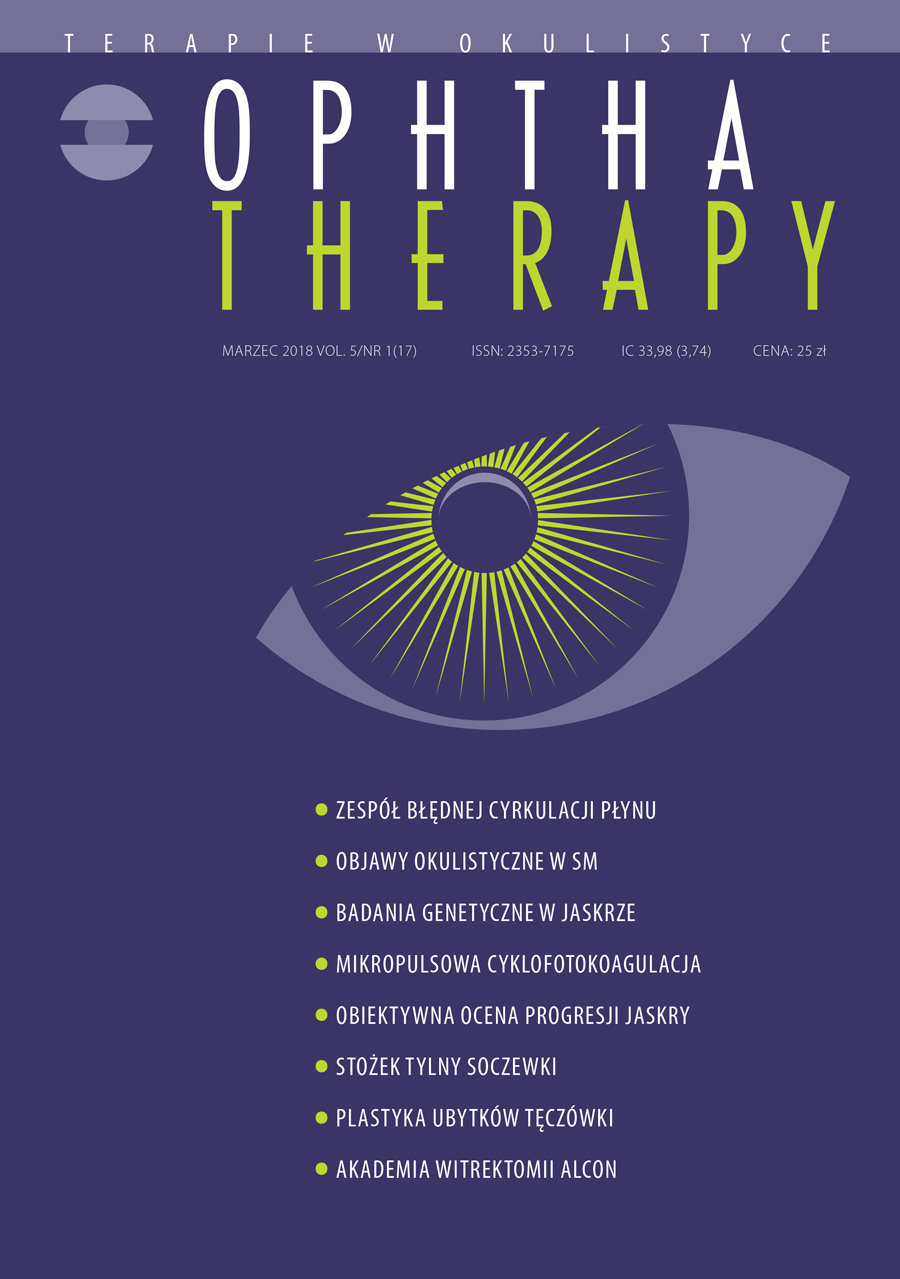Importance of the reliable glaucoma progression follow-up in the clinical practice
Main Article Content
Abstract
Glaucoma is globally, according to WHO reports, the first cause of irreversible blindness worldwide. The disease is responsible for 5.2 mln of total visual loss cases. Main problem with glaucoma still remains the same – the late diagnosis and late therapy onset. On the second place, we should mention inappropriate therapy course due to low patients compliance, too conservative doctors approach and difficulites with correct interpreting of the imaging tests, as well as with establishing glaucoma progression rate. Last but not least, problems with diagnostic tests availability should also be mentioned. In the last decade, several new diagnostic instruments, based on laser optics became more widespread. Besides the acquistion of high resolution images of the eye tissues, together with obtaining its precise measuerements, there is truly one key advantage: the possibility of making computer assisted calculatons of the progression rate and trends of measured parameters. However, this advantage is too rarely utilized in ophthalmologists everyday practice. It enables the reliable asssesment of the effectiveness of our therapy, telling us if sometning more should be done. Our thereputic decisions, concerning the choice between topical medications, laser or surgery should always by accompanied by the long term diagnostic tests analysis, using the implemented software progression tools.
Downloads
Article Details

This work is licensed under a Creative Commons Attribution-NonCommercial-NoDerivatives 4.0 International License.
Copyright: © Medical Education sp. z o.o. License allowing third parties to copy and redistribute the material in any medium or format and to remix, transform, and build upon the material, provided the original work is properly cited and states its license.
Address reprint requests to: Medical Education, Marcin Kuźma (marcin.kuzma@mededu.pl)
References
2. Leske MC, Heijl A, Hussein M et al. Early Manifest Glaucoma Trial Group. Factors for glaucoma progression and the effect of treatment: the early manifest glaucoma trial. Arch Ophthalmol. 2003; 121(1): 48-56.
3. Lee JM, Caprioli J, Nouri-Mahdavi K et al. Baseline prognostic factors predict rapid visual field deterioration in glaucoma. Invest Ophthalmol Vis Sci. 2014; 55(4): 2228-36.
4. Vianna JR, Chauhan BC. How to detect progression in glaucoma. Prog Brain Res. 2015; 221: 135-58.
5. Yoon JY, Na JK, Park CK. Detecting the progression of normal tension glaucoma: a comparison of perimetry, optic coherence tomography, and Heidelberg retinal tomography. Korean J Ophthalmol. 2015; 29(1): 31-9.
6. Chauhan BC, Garway-Heath DF, Goñi FJ et al. Practical recommendations for measuring rates of visual field change in glaucoma. Br J Ophthalmol. 2008; 92(4): 569-73.
7. European Glaucoma Society. Terminology and guidelines for glaucoma. 3rd Edition. Dogma, Savona 2008: 117.
8. Haas A, Flammer J, Schneider U. Influence of age on the visual fields of normal subjects. Am J Ophthalmol. 1986; 101(2): 199-203.
9. Chauhan BC, Malik R, Shuba LM et al. Rates of glaucomatous visual field change in a large clinical population. Invest Ophthalmol Vis Sci. 2014; 55(7): 4135-43.
10. Heijl A, Bengtsson B, Hyman L et al. Early Manifest Glaucoma Trial Group. Natural history of open-angle glaucoma. Ophthalmology. 2009; 116(12): 2271-6.
11. Wasyluk J, Spaeth G. Individualized as opposed to standardized care for glaucoma patients – the key to success. The use of the DDLS and the Colored Glaucoma Graph. OphthaTherapy. 2015; 4(8): 240-57.
12. King C, Sherwin JC, Ratnarajan G, et al. Twenty-year outcomes in patients with newly diagnosed glaucoma: mortality and visual function. Br J Ophthalmol. 2018. https://doi.org/10.1136/bjophthalmol-2017-311595].
13. Forsman E, Kivelä T, Vesti E. Lifetime visual disability in open-angle glaucoma and ocular hypertension. J Glaucoma. 2007; 16(3): 313-9.
14. Wasyluk J, Prost ME. Jak sprawdzić, czy leczymy jaskrę skutecznie? Przegląd współczesnych metod oceny progresji neuropatii jaskrowej. Okulistyka. 2015; 2: 12-7.
15. Zhang X, Dastiridou A, Francis BA et al. Advanced Imaging for Glaucoma Study Group. Comparison of Glaucoma Progression Detection by Optical Coherence Tomography and Visual Field. Am J Ophthalmol. 2017; 184: 63-74.

